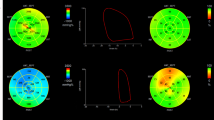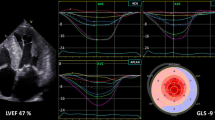Abstract
The aim of the present study was to determine the interval–contractility relationship in the same myocardial area before and after ischemia, thereby testing the hypothesis that calcium handling is impaired in stunned myocardium. Myocardial stunning was created by 15-min occlusion of the left anterior descending branch of coronary artery (LAD) followed by reperfusion in 10 open-chest dogs. Complete atrioventricular (A-V) block was achieved by injecting formaldehyde into the A-V node and the heart was paced by right ventricular electrodes. Extrasystoles at various intervals were then produced by electrical stimulation after cessation of regular pacing. Miniature force gauges were used to assess contractility. Mechanical restitution curves (MRCs) were constructed in the LAD area before and after stunning, by plotting normalized contractility against extrasystolic intervals (ESIs). The MRC was fitted to the monoexponential function FRn = FRmax {1 − Exp[(ESI-ESI0)/T c]}, where FRn is normalized contractile force, FRmax is the maximal value of a contractile response, T c is the time constant for restitution, and ESI0 is the smallest ESI that produced a mechanical response. After occlusion–reperfusion, FRmax decreased from (136.5 ± 8.2)% to (111.2 ± 5.4)%, whereas T c and ESI0 remained unchanged. These results suggested preserved sarcoplasmic reticulum function in stunned myocardium, but that the responsiveness of the contractile machinery is depressed.
Similar content being viewed by others
REFERENCES
Bers DM. Excitation–Contraction Coupling and Cardiac Contractile Force. Dordrecht: Kluwer, 1991, pp 155–158, 167–170.
Bolli R. Myocardial ‘stunning’ in man. Circulation 86(6): 1671–1691, 1992.
BolliRand Marban E. Molecular and cellular mechanisms of myocardial stunning. Phys Rev 79: 609–634, 1999.
Burkhoff D, Yue DT, Franz MR, Hunter WC, and Sagawa K. Mechanical restitution of isolated perfused canine left ventricles. Am J Physiol 246: H8–H16, 1984.
Carrozza JP Jr., Bentivegna LA, Williams CP, Kuntz RE, Grossman W, and Morgan JP. Decreased myofilament responsiveness in myocardial stunning follows transient calcium overload during ischemia and reperfusion. Circ Res 71: 1334–1340, 1992.
Chiu WC, Kedem J, Weiss HR, Tse J, Cheinberg BV, and Scholz PM. Milrinone, a cyclic AMP-phosphodiesterase inhibitor, has differential effects on regional myocardial work and oxygen consumption in experimental left ventricular hypertrophy. Cardiovasc Res 28: 1360–1365, 1994.
Day TK and Muir WW III. A technique for production of complete atrioventricular block in dogs. Am J Physiol 261: H1312–H1316, 1991.
Duncker DJ, Schulz R, Ferrari R, Garcia-Dorado D, Guarnieri C, Heusch G, and Verdouw PD. Myocardial stunning remaining questions. Cardiovasc Res 38: 549–558, 2002.
Furman E, Acad BA, Sonn J, Raul A, and Kedem J. Effect of global vs regional ischemia upon myocardial contractility and oxygen balance. Cardiovasc Res 19: 606–612, 1985.
Gao WD, Atar D, Backx PH, and Marban E. Relationship between intracellular calcium and contractile force in stunned myocardium. Direct evidence for decreased myofilament Ca2C responsiveness and altered diastolic function in intact ventricular muscle. Circ Res 76: 1036–1048, 1995.
Guo X, Kedem J, Scholz PM, and Weiss HR. Action of acetylcholine on regional myocardial work and metabolism in vivo: Association with cyclic GMP. Can J Physiol Pharmacol 74: 73–79, 1996.
Guo X, Kedem J, Weiss HR, Tse J, Roitstein A, and Scholz PM. Effect of cyclic GMP reduction on regional myocardial mechanics and metabolism in experimental left ventricular hypertrophy. J Cardiovasc Pharmacol 27: 392–400, 1996.
Hofmann PA, Miller WP, and Moss RL. Altered calcium sensitivity of isometric tension in myocyte-sized preparations of porcine postischaemic stunned myocardium. Circ Res 72: 50–56, 1993.
Hoit BD, Kadambi VJ, Tramuta DA, Ball N, Kranias EG, and Walsh RA. Influence of sarcoplasmic reticulum calcium loading on mechanical and relaxation restitution. Am J Physiol 278: H958–H963, 2000.
Institute of Laboratory Animal Resources (US). Guide for the care and use of laboratory animals, Commission on Life Science, National Research Council, National Academy Press, Washington D.C., 7th edition, 1996.
Kass RS and Sanguinetti MC. Inactivation of calcium channel current in the calf cardiac Purkinje fiber. Evidence for voltage-and calciummediated mechanisms. J Gen Physiol 84: 705–726, 1984.
Kedem J, Mahler Y, and Rogel S. The effect of heart rate on myocardial contractility during single and paired pulse stimulation “in vivo.” Archives Internationales de Physiologie et de Biochimie 77: 880–892, 1969.
Kedem J, Yarom R, Mahler Y, and Rogel S. Contraction without depolarization in the in vivo heart. Kinetic and electronmicroscopic studies. Cardiovasc Res 6: 353–359, 1972.
Kim SJ, Kudej RK, Yatani A, Kim YK, Takagi G, Honda R, Colantonio DA, Van Eyk JE, Vatner DE, Rasmusson RL, and Vatner SF. A novel mechanism for myocardial stunning involving impaired Ca(2C) handling. Circ Res 89: 831–837, 2001.
Kirkels JH, van Echteld CJ, and Ruigrok TJ. Intracellular magnesium during myocardial ischemia and reperfusion: Possible consequences for postischaemic recovery. J Mol Cell Cardiol 21: 1209–1218, 1989.
Krause SM, Jacobus WE, and Becker LC. Alterations in cardiac sarcoplasmic reticulum calcium transport in the postischaemic “stunned” myocardium. Circ Res 65: 526–530, 1989.
Kusuoka H, Koretsune Y, Chacko VP, Weisfeldt ML, and Marban E. Excitation–contraction coupling in postischemic myocardium. Does failure of activator Ca2C transients underlie stunning? Circ Res 66: 1268–1276, 1990.
LaBruno S, Naim KL, Li JK, Drzewiecki G, and Kedem J. Betaadrenergic stimulation of reperfused myocardium after 2-hour ischemia. J Cardiovasc Pharmacol 32: 535–542, 1998.
Murphy E, Steenbergen C, Levy LA, Raju B, and London RE. Cytosolic free magnesium levels in ischemic rat heart. J Biol Chem 264: 5622–5627, 1989.
Naim KL, Weiss HR, Guo X, Sadoff J, Scholz P, and Kedem J. Local inotropic stimulation by methylene blue does not improve mechanical dysfunction due to myocardial stunning. Res Exp Med 197: 23–35, 1997.
Neumann T, Ravens U, and Heusch G. Characterization of excitation–contraction coupling in conscious dogs with pacing-induced heart failure. Cardiovasc Res 37: 456–466, 1998.
Prabhu SD. Ryanodine and the left ventricular force–interval and relaxation–interval relations in closed-chest dogs: Insights on calcium handling. Cardiovasc Res 40: 483–491, 1998.
Prabhu SD and Freeman GL. Effect of tachycardia heart failure on the restitution of left ventricular function in closed-chest dogs. Circulation 9: 176–185, 1995.
Scholz PM, Kedem J, Cheinberg BV, and Weiss HR. The oxygen wasting effect of isoproterenol is altered by chemical denervation and cardiac hypertrophy. Basic Res Cardiol 91: 308–318, 1996.
Tseng GN. Calcium current restitution in mammalian ventricular myocytes is modulated by intracellular calcium. Circ Res 63: 468–482, 1988.
Valdivia C, Hegge JO, Lasley RD, Valdivia HH, and Mentzer R. Ryanodine receptor dysfunction in porcine stunned myocardium. Am J Physiol 273: H796–H804, 1997.
Wier WG and Yue DT. Intracellular calcium transients underlying the short-term force–interval relationship in ferret ventricular myocardium. J Physiol 376: 507–530, 1986.
Yue DT, Burkhoff D, Franz MR, Hunter WC, and Sagawa K. Postextrasystolic potentiation of the isolated canine left ventricle. Relationship to mechanical restitution. Circ Res 56: 340–350, 1985.
Zaugg CE, Kojima S, Wu ST, Wikman-Coffelt J, Parmley WW, and Buser PT. Intracellular calcium transients underlying interval–force relationship in whole rat hearts: Effects of calcium antagonists. Cardiovasc Res 30: 212–221, 1995.
Zeitz CJ, Ritchie RH, Jarrett RG, Hii JT, Wuttke RD, and Horowitz JD. The positive inotropic effects of milrinone but not of digoxin are attenuated at short cycle lengths. J Cardiovasc Pharmacol 35: 427–433, 2000.
Author information
Authors and Affiliations
Rights and permissions
About this article
Cite this article
Wang, X., Li, G., Ren, Y. et al. Mechanical Restitution of Contractility in Stunned Myocardium of Open-Chest Dogs. Cardiovascular Engineering 2, 57–65 (2002). https://doi.org/10.1023/A:1020929319284
Issue Date:
DOI: https://doi.org/10.1023/A:1020929319284




